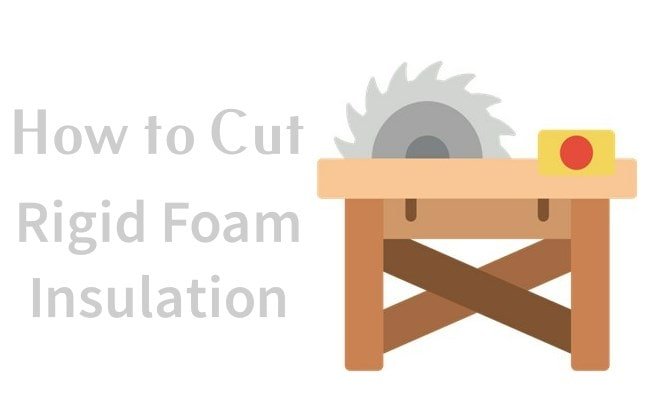Rigid insulation foam is ideal for insulating a specific area while reducing moisture and mildewing. Unlike other insulating materials, rigid insulation foam is easy to cut. Here, you’ll get information on how to cut rigid foam insulation in simple steps.
We will also share some recommendations on the best tool for cutting rigid foam insulation that any novice home repairman can use.
Preparation: How to cut rigid foam board insulation
The first step in the preparation part is crucial, especially when you plan to install spray foam insulation. Using a straightedge ruler, measure your cut accurately. Measure the length and width of the rigid foam board you’ll need for your insulation project before cutting it.
This precision ensures the foam fits perfectly into the intended space, contributing to an energy-efficient insulation setup. Check these measurements against the length and width of your rigid foam insulation to ensure it is long and wide enough.
Use a permanent marker to draw your cutting line on the foam. Use your ruler to guide you as you mark the rigid foam insulation. Draw a line along the side of your straightedge with your permanent marker, then double-check the marking to ensure it’s accurate.
Read also: Attaching the Rigid Foam Insulation Between Studs
The key on how to cut rigid foam board insulation nicely is to put it on a flat surface. It would be easier to make a perfect cut if you keep the board flat when cutting.
If you don’t have a work table, cut your foam insulation on a flat and smooth surface.
Attach your rigid foam board insulation to the flat surface using a clamp. The clamp is used to make the area a precise size so the insulation can be properly insulated. Secure both sides of the insulation to the work surface with rubber clamps.
To produce a precise incision, place the straightedge alongside the cutting line. If you don’t use clamps, your rigid foam board will likely shift or slide while you try cutting it.
Next Step, Cutting: The best tool to cut rigid foam insulation
Now to the cutting part, which is key when installing spray foam insulation. You can use several tool options to cut rigid foam board insulation, such as a utility knife, electric circular saw, hotwire cutter, or putty knife.
Each tool has advantages, depending on the type of cut required and the size of the foam insulation vs. fiberglass. If you require a precise cut, it is recommended to use an electric circular saw instead of a knife to cut rigid foam.
While utility knives can cut solid foam insulation, table saws provide a cleaner, smoother cut. If you require hard foam insulation cut to exact proportions, buy or rent a table saw.

Cutting rigid foam insulation requires attention to detail and the right tools. Whether using a utility knife for smaller projects or a table saw for larger cuts, the key is maintaining precision.
You don’t need to clamp the foam board using a table saw. You just need to cut the indicated line on the board using the saw’s blade. Hold the portable saw steady as you guide the blade through the line if you’re using one.
To prevent it from sliding, force it through the blade on the table saws. But make sure the force is enough so you don’t break the board.
Check for flaws in your rigid insulation cut. If the insulation appears to be too large or the cut appears uneven, make another cut with your electric saw. If not, remove any remaining foam dust with a brush and utilize the cut-insulating foam in the project. If you’re using a utility knife to cut your foam board insulation, securing it with a clamp is essential.
Opt for a utility knife with a segmented blade. The ridges at the bottom can help you measure and cut more accurately along the line. Aim to cut just outside the line’s edge to ensure precision and avoid removing excess foam.
Read also: Can You Paint Foam Board Insulation?
Expert Advice: For those who need to cut a lot of foam, consider using a hot knife. Heating your utility knife before cutting can also result in a smoother cut, making the process more efficient.
Cost and Efficiency in Cutting Rigid Foam Insulation
Understanding the cost of spray foam insulation is important when considering how to cut rigid foam insulation. While the initial investment in materials and tools might be higher than other insulation types, the ability to cut and install spray foam insulation precisely can significantly reduce energy costs in the long run.
Additionally, different types of closed-cell spray foam may require specific cutting techniques to ensure optimal fit and insulation effectiveness.
Now you know how to cut rigid foam board insulation. The rigid foam board is a simple-to-use insulation option that saves you money on utility expenses. Sculptors and construction workers employ various foam-cutting techniques to create stiff foam figures.
Remember, the right cutting technique not only ensures a perfect fit for your insulation but also contributes to the overall effectiveness of your insulation project.
Read also: Rigid Foam Over Batt Insulation, Why Not?
Tools for Cutting Rigid Foam Insulation
| Tool | Advantages | Disadvantages |
|---|---|---|
| Utility Knife | Easy to handle, inexpensive | May not provide the cleanest cut |
| Electric Circular Saw | Provides precise, smooth cuts | Requires careful handling, higher cost |
| Hot Wire Cutter | Smooth and clean cuts, suitable for detailed work | Can be expensive, and requires a power source |
| Putty Knife | Good for small, simple cuts | Limited to thin or small foam pieces |
| Table Saw | Best for large and precise cuts | High cost, needs ample space for operation |
Detailed Tool Tips
Various tools can be used to cut polystyrene insulation, including hand saws, hot wire cutters, long-blade utility knives, and jigsaws. Each tool offers unique advantages:
- Hand Saw: Ideal for precision cutting due to its fine-toothed blade. Recommended for cutting on a firm surface to prevent cracking.
- Hot Wire Cutter: Provides the quickest and neatest cuts. Safety precautions are essential due to the high temperatures involved.
- Long Blade Utility Knife: Suitable for small, thin pieces of polystyrene. Sharp edges and proper safety gear are crucial for effective use.
- Jigsaw: Useful for larger or intricate cuts. Requires caution to prevent foam from melting due to friction.
Real-Life Example: When cutting polystyrene with a hand saw, it’s recommended to use a fine-toothed saw for precision cutting. The process is smooth as polystyrene generates no resistance. Performing sawing on a firm surface prevents cracking. Selecting high-quality hand saws with sharp teeth and a comfortable handle ensures efficient cutting.
Conclusion
In conclusion, knowing how to cut rigid foam insulation is essential for a successful installation, especially when considering the cost of spray foam and its impact on energy efficiency.
Whether you’re using open-cell spray foam insulation or other types, the right cutting technique ensures a perfect fit and contributes to the overall effectiveness of your insulation project.
The most risky method for cutting foam insulation and padding is using a cutting instrument. As a result, you must select a cutting instrument with utmost caution and follow the methods outlined above.


